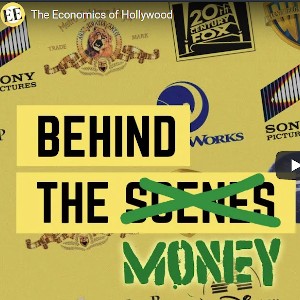I’ve been watching a lot of videos about economics recently for research into a new project I’m working on. This channel Economics Explained is one of my favorites. The creator does a great job breaking down the topic and adds a fun bit of sarcastic humor. Bonus that he has a nice Aussie accent. 🙂
This video breaks down funding, product placement, tax incentives, box office income, and other topics.
Join the PERA (Personal Entertainment Research Assistant) waitlist.
The World's Most Indispensable Movie App
The RunPee app tells you the best times to
run & pee during a movie
so you don't miss the best scenes.
Download the RunPee app.
100% free (donation supported)
$42 billion dollars. That is the amount of money grossed by films at the global box office in 2019. Impressive? Definitely. Surprising? Probably not, especially when you consider that global box office revenues have increased year-over-year since 2005.
That was, of course, until COVID. As you’d expect, the pandemic has devastated Hollywood – resulting in an unprecedented seventy-one percent (71%) decline in global box office revenue. Worse yet, we all have to go another year without Daniel Craig’s No Time To Die – a title that has since taken on somewhat of an eerie meaning. But putting the absence of James Bond aside…movie ticket sales have actually been on the decline for nearly two decades – despite a steady increase in population over the same period.
What people are saying
about the RunPee app.
Water drinkers unite
Run pee is the best app for people who find themselves needing to pee a lot but also not wanting to miss any action. The app gives you the best times to use the bathroom during a movie while also telling you when to leave and which lines to listen for! It not only gives you the time you should go pee, but it also explains to you what is happening during the break. I helped I use this app every time I go to the movies now. My god father recommended this app to 5 years ago and it’s been in my phone ever since! Highly recommended.
View all reviews
Apple App Store | Google Play Store
Download RunPee app
So, if people are going to movie theatres less often – and they are – then what exactly is driving the growth behind global box office revenue? To answer this question, you have to understand the economics of Hollywood. How do movies get funded? What is the role of government subsidies and alternative revenue sources? How can a movie gross more than its budget and still lose money?
And finally, what are the economics behind movie theatres and their twenty-dollar buckets of popcorn?
Creator and developer of the RunPee app. When something doesn’t work right in the app it’s pretty much his fault. 🙂
Aspiring author. Would like to finish his “Zombie Revelations” trilogy if he could break away for working on RunPee and the cottage he’s building for RunPee Mom.





